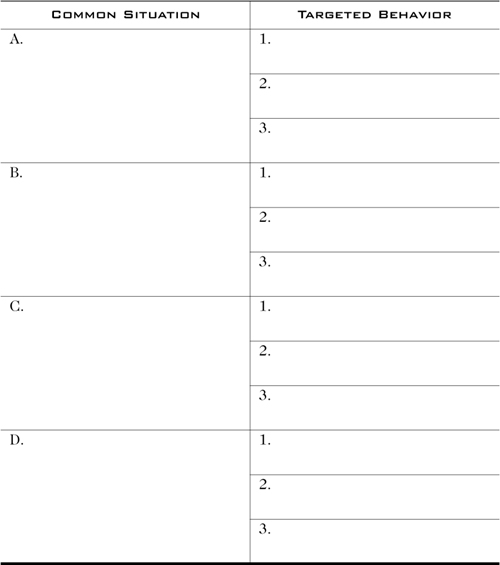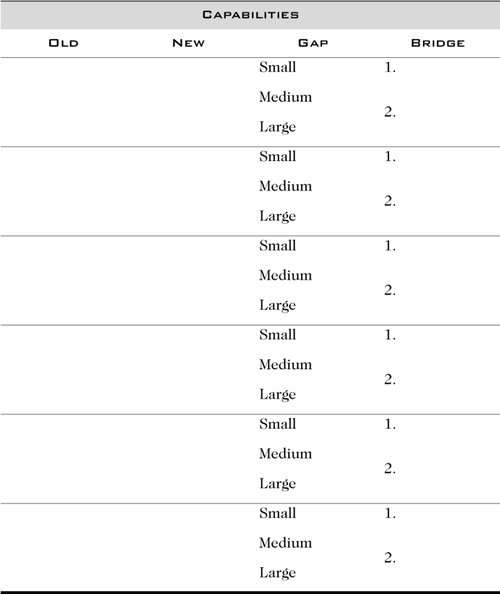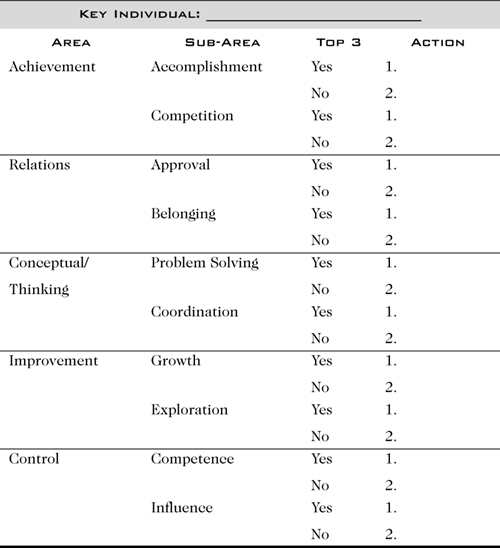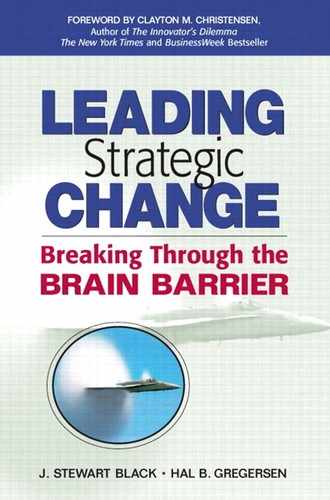Chapter 10
Leading
Strategic Change
Toolkit: Believing
People must conceive the need for change, but this alone is not sufficient. Simply recognizing that the old right thing is now wrong is not enough. They must clearly envision the new right thing and believe in a path that will take them from doing the new right thing poorly to doing it well. Once they believe in the path, you can get the lift needed to overcome their failure to move. As discussed earlier, the three keys to lift and movement are destinations, resources, and rewards. Next we want to review these principles briefly and highlight some practical tools for ensuring movement.
Destinations
People not only need to recognize that the old thing is now wrong, but they must also see with clarity what the new right thing is. Although this is a necessary step, it alone cannot deliver movement to change. People also need to envision where they are headed as they move forward; they must see the new promised land in their mind's eye. It's one thing to say, "In the past, we practiced customer indifference, but in the future, we will put customers first." It is quite another to translate the promised land of Customer 1st into clear targets that individuals can aim at and actually hit.
This is why the key practical step in establishing effective targets is translating the vision of the new right thing into concrete behaviors. For example, if Customer 1st is the new vision, what will that look like in terms of behavior? How would you recognize Customer 1st behavior if you saw it? For example, in the case of Sam, our airline gate agent, when a customer comes late to the gate, one concrete behavior of the new Customer 1st vision is empathizing with customer frustration at missing flights. Another behavior is proactively working to help customers get to their destinations. Only when targets are this concrete and clear will Sam move forward.
A consistent exercise we engage managers in is clarifying the new right thing in terms of concrete behaviors. The more complex the vision in which the new right thing must be accomplished, the greater the need first to define the most common situations that will create that complex change, then to describe the concrete behaviors in those situations that support the new vision. For example, in Sam's case, one of the most common situations for making the vision of Customer 1st a reality happens when someone arrives late to the gate. Another common situation occurs when flights are delayed or cancelled. The tool in Exhibit 10-1 can help you define key situations in your change initiative, then describe in detail the relevant desired behaviors.
Exhibit 10-1 Identifying Situations and Desired Response Behaviors

This approach to change may seem detailed, but we have noticed two important implications in our research and work with clients. First, without clear and concrete target behaviors, most people will not move. So, although it may take a bit of time and effort to detail the most common situations and describe the targeted behaviors, the negative returns for not doing this, compared with the positive returns for the time and effort for doing it, make the decision to invest an easy one. Second, we have discovered that if you focus on the 20% of situations—and related target behaviors—that cover 80% of the new vision, the rest of the less core situations and behaviors take care of themselves.
What do we mean that the rest take care of themselves? To illustrate, return to Sam our airline gate agent. For Sam, two situations—customers arriving late and delayed (or cancelled) flights—are within the critical core 20% that account for 80% of all customer service situations. By knowing what the targeted behaviors are for these core situations, Sam can "fill in the blanks" regarding Customer 1st behaviors for less common situations reasonably well on his own. That is, as Sam encounters the other less common situations, he can reasonably extrapolate from the identified core situations and make reasonably sound judgments as to what the targeted behaviors should be. The implication of this point is critical. If you take the time and invest the resources to identify the core 20% of situations and describe the related target behaviors, you will not need to make the same resource investment in the remaining; you will have equipped your people to do that job for you.
Resources
Now your people should have a clear idea of the target. Part of their "motivation to move" equation is solved. Next, you must ensure that they believe they have the resources to make the journey. Remember, we are talking about a wide variety of resources—tools, knowledge, capabilities, etc.—to make change happen. Movement requires that movers believe they have what it takes. For example, people can have the sales capabilities but lack product knowledge and, as a consequence, lack the motivation to move.
To support movement fully, we use the charts in Exhibit 10-2 to help map out the full spectrum of required resources. These charts also help you identify the necessary actions to supply your people with needed resources so that they can individually bridge the gap between what they have and what they need.
Exhibit 10-2 Required Resources Charts

Rewards
Once people can see the targets clearly and believe they have what it takes to hit the targets, the remaining key to movement is instilling a belief that they will receive valued rewards along the path to the desired change. As discussed before, most managers need little help in using financial incentives to motivate movement. However, financial incentives are expensive, and they are not always completely within the control of those trying to lead the change. In addition, many other, more readily available rewards are just as powerful and often more motivating than traditional financial incentives.
Here we want to reiterate that, although everyone is likely motivated to some extent by all of the following, they are not motivated equally. This is why it is worth the time and effort to consider key people who need to move or change and generate a clear image of their most powerful motivators, as well as what actions you can take to produce those motivators.
We use the tool in Exhibit 10-3 to help with this diagnosing and planning process. We start by identifying the key individuals to motivate and move. In every organization or subunit, we always find key informal leaders and trend-setters. Quite often, if you can get them moving, others follow. Next, we go through each of the motivation areas and sub-areas on the chart to determine which we believe to be the top three most powerful in motivating that specific individual. Finally, for each of the top three areas, we write out a few concrete actions that can be taken to motivate the person. Again, although this tool represents a significant investment of time and energy, the negative consequences of not performing this step and the positive payoffs of spending the time and effort make it one you can't afford to skip.
Exhibit 10-3 Tool for Determining Motivation of Key Individuals

Summary
With clear destinations, required resources, and valued rewards, you can break through the failure-to-move barrier. With that breakthrough, you now must work to sustain the change and achieve lasting results. Overcoming the final barrier to change— failure to finish—may well be the most difficult.
